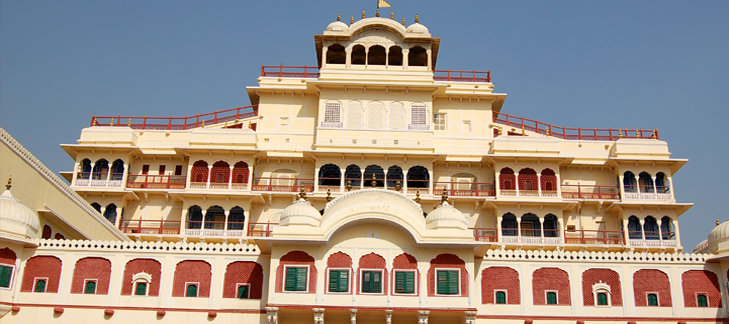City Palace, Jaipur Travel Information
The City Palace, which includes the Chandra Mahal and Mubarak Mahal palaces and other buildings, is a palace complex in Jaipur. It was the seat of the Maharaja of Jaipur, the head of the Kachwaha Rajput clan. The palace complex incorporates an impressive and vast array of courtyards, gardens and buildings. The palace was built between 1729 and 1732, initially by Sawai Jai Singh II, the ruler of Amber. He planned and built the outer walls, and later additions were made by successive rulers, right up to the 20th century. The most prominent and most visited structures in the complex are the Chandra Mahal, Mubarak Mahal, Mukut Mahal, Maharani's Palace, Shri Govind Dev Temple and the City Palace Museum.
Chandra Mahal or Chandra Niwas is the most commanding building in the City Palace complex. It is a seven-storied building and each floor has been given a specific name, such as the Sukh-Niwas, Ranga-Mandir, Pitam-Niwas, Chabi-Niwas, Shri-Niwas and Mukut-Mandir or Mukut Mahal. It contains many unique paintings, mirrorwork and floral decorations. At present, most of this palace is the residence of the descendents of the former rulers of Jaipur. Only the ground floor is allowed for visitors where a museum is located that displays carpets, manuscripts and other items that belonged to the royal family. There is beautiful peacock gate at the entry to the Mahal. It has screened balconies and a pavilion at the roof from where a panoramic view of the city can been seen.
Mubarak Mahal, meaning “the auspicious palace,” was built with a fusion of Islamic, Rajput and European architectural styles in the late 19th century by Maharaja Madho Singh II as a reception center. It houses a fine collection of a variety of textiles such as the royal formal costumes, sanganeri block prints, embroidered shawls, Kashmiri pashminas and silk saris as part of the Maharaja Sawai Man Singh II Museum.
Maharani's Palace was originally the residence of the royal queens. It has been converted into a museum, where weapons used by the royalty during war campaigns are displayed, including those dating back to the 15th century. The ceiling of this chamber has unique frescoes, which are preserved using jewel dust of semiprecious stones. Artifacts on display include swords with pistols attached, the sword presented by Queen Victoria to Maharaja Sawai Ram Singh which is inlaid with rubies and emeralds, guns serving as walking sticks and a small canon which could be mounted on a camel's back.
Govind Dev Ji temple, dedicated to the Hindu god Lord Krishna, is part of the City Palace complex. Built in the early 18th century, the temple houses several European chandeliers and paintings. The ceiling in the temple is ornamented in gold. Its location provided a direct view to the Maharaja from his Chandra Mahal palace.

View All Sights of Jaipur
Sights Main Menu >>

